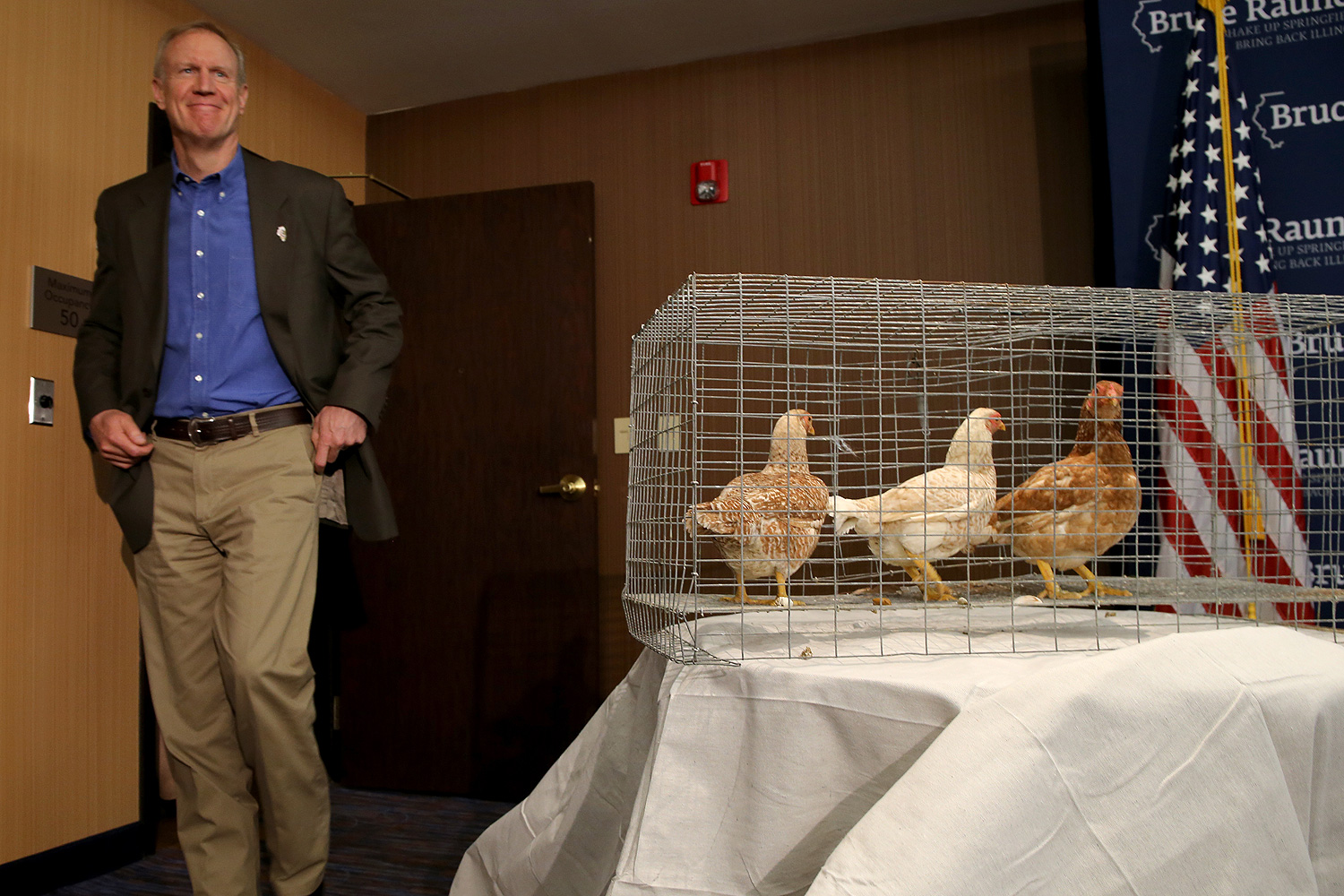GOP gubernatorial candidate Bruce Rauner held a press conference yesterday to announce his long-awaited to fix Illinois's budget. He had an opening act:
In what he called a “turning point” in his campaign, Rauner stood beside a trio of caged chickens, pointing to them as what was wrong with Illinois.
“We have spent over $100,000 flying chickens into our state. We have plenty of chickens in our state and certainly if we were desperate for more, we could drive them,” Rauner said. “We don’t need to fly them in to the cost of $100,000.”
In short, the state recently flew prairie chickens from Kansas to restock the state's tiny population and add some genetic diversity to that population. The total cost of the flights was $7,400, according to the Audubon Society, which kicked in $30,000 towards the project, putting the per-bird cost at $81 a head—closer to the market rate for a one-way flight from Kansas, at least when compared to people. (The state's share was paid for not through general tax dollars, but IDNR funding from outdoor fees.)
This story's been floating around for a month or so. In May, John Kass was all set to rip into it, but after making some phone calls came down defiantly pro-prairie chicken. And he has a lot of company in state history. Even as the population has hovered near disappearance for 50-some years, its defenders have remained stalwart.
As early as the 1880s, when the population is believed to have been in the millions, the Illinois Natural History Survey was sounding the alarm. The state began cutting back on the prairie chicken hunting season, finally eliminating it in the 1930s, when the population was down to some 25,000. But hunting wasn't the ultimate problem; land was. So the population continued to decline, to around 2,000 in the early 1960s.
At that point, the private Prairie Chicken Foundation of Illinois came into being, purchasing land for sanctuaries with the help of the Nature Conservancy and some of the biggest families in the state—the Donnelly printing brothers, steel-pipe scion and conservationist Cyrus Mark, Chauncey McCormick of the famous McCormick/Medill family. Their efforts largely failed as well:
In the summer of 1965, captive-reared prairie chickens were released on Cook County Forest Preserve District land near Barrington; but the birds vanished quickly, probably caught by predators. Prairie chickens do poorly in areas near trees, because hawks and owls perching there prey on them. But even birds introduced on extensive grasslands out of the reach of such predators tend to die off. Reintroduction efforts on extremely large expanses of grassland in Oklahoma, for example, have failed. "What usually happens is that they're reintroduced, and the birds are just totally disoriented," said Westemeier. "They fly until they die, essentially. The birds are dead within a few days, or maybe a month or two at most."
As the prairie chicken population leveled out at an almost non-existent number, the Department of Natural Resources-managed sanctuary lands grew from 77 acres to almost 4,000 today. But as the lands expanded, the genetic landscape of Illinois prairie chickens remained narrow:
The result was a loss of genetic variation, which may have important consequences for the long-term viability of a population, possibly decreasing resistance to disease and parasites, and the ability of populations to respond to environmental changes. Another result of this genetic loss was lowered egg viability. From a hatching success of 91 to 100 percent in the 1960s, the rate in 1990 fell to 38 percent, and despite best efforts, the number of birds bottomed out in 1994, at 46.
Thus began the prairie chicken translocation effort, more than 20 years before it came into the crosshairs of Bruce Rauner:
The solution was to bring in new recruits. Between 1992 and 1998 a total of 271 greater prairie chickens from populations in Minnesota, Kansas, and Nebraska were relocated to Jasper County, while an additional 235 were released in Marion County, for a grand total of 506. Hatching success rebounded to as much as 94 percent. But the population continued to struggle as a series of cold, wet springs made the survival of newly hatched broods an even more treacherous business than usual. Fortunately, in the past few years the weather has been kinder. In 2007 the closely monitored population count was 51 males in Jasper County (up from 37 in 2006) and 59 males in Marion County (up from 48 in 2006).
More recently, the population has continued to struggle, most recently because of the 2012 drought. Even after the controversial prairie chicken translocation of 2014, the population is vanishingly small, though the importing of 200 more is planned through 2016.
Bruce Rauner, if elected, could finally decide the fate of the prairie chicken in Illinois. It wouldn't take much more than a legislative shrug. But there's a lot more to it than chickens: "The 35 years [now much more] of data represent one of the most detailed sets of data ever collected from an isolated and declining wildlife population." Had the plow and the suburb taken its course, the prairie chicken would have been gone long ago, but it has a lot of momentum behind it, if not genetics or luck—a century of scientists, advocates, and citizens who have been unwilling to give up on the modest little bird.




